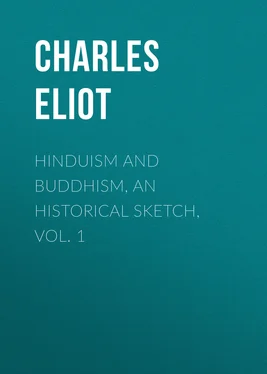Charles Eliot - Hinduism and Buddhism, An Historical Sketch, Vol. 1
Здесь есть возможность читать онлайн «Charles Eliot - Hinduism and Buddhism, An Historical Sketch, Vol. 1» — ознакомительный отрывок электронной книги совершенно бесплатно, а после прочтения отрывка купить полную версию. В некоторых случаях можно слушать аудио, скачать через торрент в формате fb2 и присутствует краткое содержание. Жанр: foreign_religion, Философия, Религиозная литература, foreign_psychology, foreign_antique, foreign_prose, на английском языке. Описание произведения, (предисловие) а так же отзывы посетителей доступны на портале библиотеки ЛибКат.
- Название:Hinduism and Buddhism, An Historical Sketch, Vol. 1
- Автор:
- Жанр:
- Год:неизвестен
- ISBN:нет данных
- Рейтинг книги:5 / 5. Голосов: 1
-
Избранное:Добавить в избранное
- Отзывы:
-
Ваша оценка:
- 100
- 1
- 2
- 3
- 4
- 5
Hinduism and Buddhism, An Historical Sketch, Vol. 1: краткое содержание, описание и аннотация
Предлагаем к чтению аннотацию, описание, краткое содержание или предисловие (зависит от того, что написал сам автор книги «Hinduism and Buddhism, An Historical Sketch, Vol. 1»). Если вы не нашли необходимую информацию о книге — напишите в комментариях, мы постараемся отыскать её.
Hinduism and Buddhism, An Historical Sketch, Vol. 1 — читать онлайн ознакомительный отрывок
Ниже представлен текст книги, разбитый по страницам. Система сохранения места последней прочитанной страницы, позволяет с удобством читать онлайн бесплатно книгу «Hinduism and Buddhism, An Historical Sketch, Vol. 1», без необходимости каждый раз заново искать на чём Вы остановились. Поставьте закладку, и сможете в любой момент перейти на страницу, на которой закончили чтение.
Интервал:
Закладка:
It is difficult to say whether monotheism is a development of this nature worship or has another origin. In Japanese religion the monotheistic tendency is markedly absent. The sun-goddess is the principal deity but remains simply prima inter pares . But in the ancient religion of China, T'ien or Heaven, also called Shang-ti, the supreme ruler, though somewhat shadowy and impersonal, does become an omnipotent Providence without even approximate rivals. Other superhuman beings are in comparison with him merely angels. Unfortunately the early history of Chinese religion is obscure and the documents scanty. In India however the evolution of pantheism or theism (though usually with a pantheistic tinge) out of the worship of nature forces seems clear. These gods or forces are seen to melt into one another and to be aspects of one another, until the mind naturally passes on to the idea that they are all manifestations of one force finding expression in human consciousness as well as in physical phenomena. The animist and pantheist represent different stages but not different methods of thought. For the former, every natural object which impresses him is alive; the latter concurs in this view, only he thinks the universe is instinct with one and the same life displaying itself in infinite variety.
One difficulty incidental to the treatment of Asiatic religions in European languages is the necessity, or at any rate the ineradicable habit, of using well-known words like God and soul as the equivalents of Asiatic terms which have not precisely the same content and which often imply a different point of view. For practical life it is wise and charitable to minimize religious differences and emphasize points of agreement. But this willingness to believe that others think as we do becomes a veritable vice if we are attempting an impartial exposition of their ideas. If the English word God means the deity of ordinary Christianity, who is much the same as Allah or Jehovah—that is to say the creator of the world and enforcer of the moral law—then it would be better never to use this word in writing of the religions of India and Eastern Asia, for the concept is almost entirely foreign to them. The nature spirits of which we have been speaking are clearly not God: when an Indian peasant brings offerings to the tomb of a deceased brigand or the Emperor of China promotes some departed worthy to be a deity of a certain class, we call the ceremony deification, but there is not the smallest intention of identifying the person deified with the Supreme Being, and odd as it may seem, the worship of such "gods" is compatible with monotheism or atheism. In China, Shang-ti is less definite than God 104 104 0This impersonality is perhaps a later characteristic. The original form of the Chinese character for T'ien Heaven represented a man. The old Finnish and Samoyede names for God—Ukko and Num—perhaps belong to this stage of thought.
and it does not appear that he is thought of as the creator of the world and of human souls. Even the greater Hindu deities are not really God, for those who follow the higher life can neglect and almost despise them, without, however, denying their existence. On the other hand Brahman, the pantheos of India, though equal to the Christian God in majesty, is really a different conception, for he is not a creator in the ordinary sense: he is impersonal and though not evil, yet he transcends both good and evil. He might seem merely a force more suited to be the subject matter of science than of religion, were not meditation on him the occupation, and union with him the goal, of many devout lives. And even when Indian deities are most personal, as in the Vishnuite sects, it will be generally found that their relations to the world and the soul are not those of the Christian God. It is because the conception of superhuman existence is so different in Europe and Asia that Asiatic religions often seem contradictory or corrupt: Buddhism and Jainism, which we describe as atheistic, and the colourless respectable religion of educated Chinese, become in their outward manifestations unblushingly polytheistic.
Similar difficulties and ambiguities attend the use of the word soul, for Buddhism, which is supposed to hold that there is no soul, preaches retribution in future existences for acts done in this, and seeks to terrify the evil doer with the pains of hell; whereas the philosophy of the Brahmans, which inculcates a belief in the soul, seems to teach in some of its phases that the disembodied and immortal soul has no consciousness in the ordinary human sense. Here language is dealing with the same problems as those which we describe by such phrases as the soul, immortality and continuous existence, but it is striving to express ideas for which we have little sympathy and no adequate terminology. They will be considered later.
But one attitude towards that which survives death is almost universal in Eastern Asia and also easily intelligible. It finds expression in the ceremonies known as ancestor worship. This practice has attracted special attention in China, where it is the commonest and most conspicuous form of religious observance, but it is equally prevalent among the Hindus, though less prominent because it is only one among the many rites which engage the attention of that most devout nation. It is one of the main constituents in the religions of Indo-China and Japan, though the best authorities think that it was not the predominant element in the oldest form of Shinto. It is less prominent among the Tibeto-Burmese tribes but not absent, for in Tibet there are both good and evil ghosts who demand recognition by appropriate rites. It is sometimes hard to distinguish it from the worship of natural forces. For instance in China and southern India most villages have a local deity who is often nameless. The origin of such deities may be found either in a departed worthy or in some striking phenomenon or in the association of the two.
The cult of ghosts may be due to either fear or affection, and both motives are found in Eastern Asia. But though abundant examples of the propitiation of angry spirits can be cited, respect and consideration for the dead are the feelings which usually inspire these ceremonies at the present day and form the chief basis of family religion. There is no need to explain this sentiment. It is much stronger in Asia than in Europe but some of its manifestations may be paralleled by masses and prayers for the dead, others by the care bestowed on graves and by notices in memoriam . As a rule both in China and India only the last three generations are honoured in these ceremonies. The reason is obvious: the more ancient ancestors have ceased to be living memories. But it might be hard to find a theoretical justification for neglecting them and it is remarkable that in all parts of Asia the cult of the dead fits very awkwardly into the official creeds. It is not really consistent with any doctrine of metempsychosis or with Buddhist teaching as to the impermanence of the Ego. In China may be found the further inconsistency that the spirit of a departed relative may receive the tribute of offerings and salutations called ancestor worship, while at the same time Buddhist services are being performed for his deliverance from hell. But of the wide distribution, antiquity and strength of the cult there can be no doubt. It is anterior not only to Brahmanism but to the doctrines of transmigration and karma, and the main occupation of Buddhist priests in China and Japan is the performance of ceremonies supposed to benefit the dead. Even within Buddhism these practices cannot be dismissed as a late or foreign corruption. In the Khuddaka-pâṭha which, if not belonging to the most ancient part of the Buddhist canon, is at least pre-Christian and purely Indian, the dead are represented as waiting for offerings and as blessing those who give them. It is also curious that a recent work called Raymond by Sir O. Lodge (1916) gives a view of the state after death which is substantially that of the Chinese. For its teaching is that the dead retain their personality, concern themselves with the things of this world, know what is going to happen here and can to some extent render assistance to the living 105 105 0See the account of the Faunus message in this book.
. Also (and this point is specially remarkable) burning and mutilation of the body seem to inconvenience the dead.
Интервал:
Закладка:
Похожие книги на «Hinduism and Buddhism, An Historical Sketch, Vol. 1»
Представляем Вашему вниманию похожие книги на «Hinduism and Buddhism, An Historical Sketch, Vol. 1» списком для выбора. Мы отобрали схожую по названию и смыслу литературу в надежде предоставить читателям больше вариантов отыскать новые, интересные, ещё непрочитанные произведения.
Обсуждение, отзывы о книге «Hinduism and Buddhism, An Historical Sketch, Vol. 1» и просто собственные мнения читателей. Оставьте ваши комментарии, напишите, что Вы думаете о произведении, его смысле или главных героях. Укажите что конкретно понравилось, а что нет, и почему Вы так считаете.












